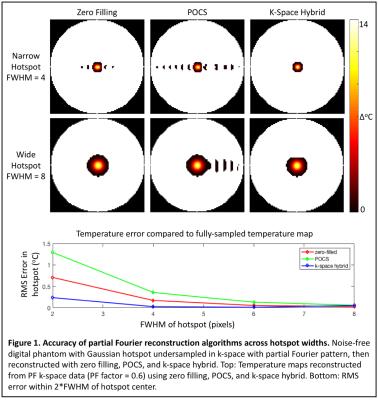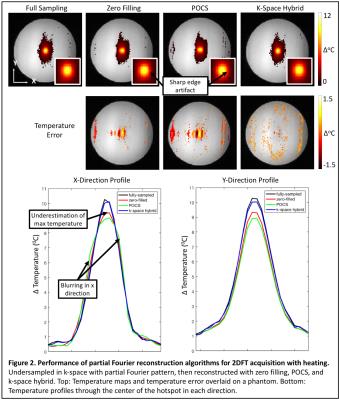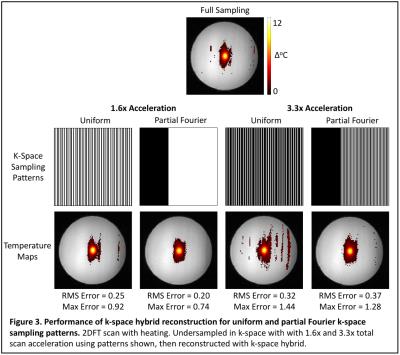5425
Highly accelerated Cartesian MR thermometry without parallel imaging using undersampled partial Fourier acquisition and k-space hybrid reconstruction1Department of Biomedical Engineering, Vanderbilt University, Nashville, TN, United States, 2Institute of Imaging Science, Vanderbilt University, Nashville, TN, United States
Synopsis
Partial Fourier temperature mapping using the k-space hybrid algorithm is shown to be more accurate than conventional partial Fourier reconstruction, and the use of partial Fourier acquisition patterns improves the performance of the k-space hybrid algorithm. Undersampled partial Fourier acquisition with k-space hybrid reconstruction can be used to achieve highly accelerated, artifact-free temperature mapping with a robust Cartesian acquisition. Reconstruction is parallelized in the slice dimension and frequency-encoded dimension to achieve real-time volumetric EPI temperature mapping, without parallel imaging.
Introduction
For MR-guided high-intensity focused ultrasound (HIFU) therapy, temperature maps must be acquired in real time with large volume coverage to measure heating at tissue interfaces far from the ultrasound focus1. Parallel imaging2 (PI) is typically used for MRI scan acceleration. However, current clinical MR-HIFU systems do not use PI because the HIFU transducer prevents close coil positioning, which severely limits PI acceleration. Partial Fourier (PF) acquisitions with zero-filled reconstruction have been used for thermometry3, but as will be shown, zero-filled PF temperature maps are inaccurate for narrow hot spots. Another temperature scan acceleration approach is the k-space hybrid temperature algorithm4, which reconstructs accurate temperature maps from undersampled k-space data by exploiting redundancies between dynamic and baseline data. It enables very high scan acceleration factors using non-Cartesian k-space trajectories, but acceleration is more limited when reconstructing from uniformly undersampled Cartesian data (2DFT or EPI). Here we will show that a) the k-space hybrid algorithm is more accurate than other PF reconstructions, and b) that uniformly undersampled PF k-space hybrid temperature mapping is more accurate than uniformly undersampled full k-space reconstruction with the same scan acceleration factor. The result is an accurate, highly accelerated MR temperature mapping approach that is based on robust Cartesian acquisitions and does not require parallel imaging.Methods
Simulation
To compare the k-space hybrid algorithm with zero-filled and POCS algorithms for PF temperature reconstruction, a cylindrical phantom with matrix size 144x192 was simulated with a centered Gaussian hotspot (FWHM between 2 and 10 pixels), and a maximum heat-induced phase shift of π/2. k-Space data were synthesized from the phantom images using a PF factor of 0.6. Temperature maps were reconstructed using each algorithm, and temperature accuracy was measured by as the RMS error in the hotspot.
Phantom HIFU Heating Experiment
2DFT HIFU heating data in a tissue-mimicking phantom were acquired with a 112x112 matrix size on a 3T scanner using a Philips Sonalleve MR-HIFU system (Philips Healthcare, Vantaa, Finland). The data were retrospectively undersampled (PF factor = 0.61) and reconstructed with each zero filling, POCS, and k-space hybrid. The baseline images for zero filling and POCS were also PF reconstructions, which was found to always be more accurate (results not shown). The data were then undersampled with both uniform undersampling patterns and undersampled PF patterns to achieve acceleration factors of 1.6x and 3.3x. K-space hybrid was used to reconstruct temperature maps for each pattern.
Results
Simulation
Figure 1 shows that while all three reconstruction algorithms produced accurate temperature maps for wide hotspots, k-space hybrid was most accurate, especially for narrow hotspots. Artifacts and blurring are evident in the zero-filled and POCS reconstructions. Small hotspots contain high-frequency signal that is truncated on one side of k-space in a PF acquisition, resulting in blurring in zero-filled and POCS reconstructions. In contrast, k-space hybrid leverages prior knowledge of the baseline image magnitude and makes no assumptions about the data in the unsampled region of k-space.
Phantom HIFU Heating Experiment
Figure 2 shows that both POCS and zero filling produced temperature maps with slight blurring and underestimation of maximum temperature, consistent with the simulations. They also contain sharp edge artifacts on the right side of the hotspot. k-Space hybrid results in virtually artifact-free PF temperature maps. Figure 3 further shows that undersampled PF with k-space hybrid is more accurate than uniform undersampling of all of k-space for the same number of k-space lines, due to higher sampling density in the undersampled PF case. The uniformly-undersampled maps contain coherent aliasing artifacts, while the undersampled PF maps contain no visible artifacts.
Discussion
Undersampled PF temperature mapping using the k-space hybrid algorithm is more accurate than conventional PF reconstruction, and can further be used to achieve highly accelerated temperature mapping with no PI acceleration and a robust Cartesian acquisition. Figure 4 illustrates how real-time k-space hybrid reconstruction can be implemented using parallelization across the frequency-encoded dimension. Future work will leverage this parallelization opportunity plus across-slice parallelization to achieve real-time volumetric EPI temperature mapping, without parallel imaging.Acknowledgements
This project was supported by the Focused Ultrasound Foundation, the Vanderbilt University Summer Research Program, and NIH grant R24 MH 109105.References
1. Moonen CT, Quesson B, Salomir R, Vimeux FC, de Zwart J, Van Vaals JJ, Grenier N, Palussiere J. Thermal therapies in interventional MR imaging. Focused ultrasound. Neuroimaging Clin N Am 2001;11:737–747.
2. Lustig M, Pauly JM. SPIRiT: Iterative Self-consistent Parallel Imaging Reconstruction from Arbitrary k-Space. Magn Reson Med. 2010;64(2):457-471. doi:10.1002/mrm.22428.
3. Holbrook AB, Santos JM, Kaye E, Rieke V, Pauly KB. Real Time MR Thermometry for Monitoring HIFU Ablations of the Liver. Magn Reson Med. 2010;63(2):365-373. doi:10.1002/mrm.22206.
4. Gaur P, Grissom WA. Accelerated MRI thermometry by direct estimation of temperature from undersampled k-space data. Magn Reson Med. 2015;73:1914–1925.
Figures



